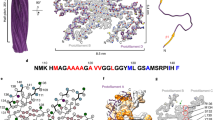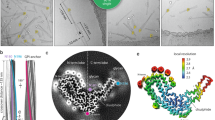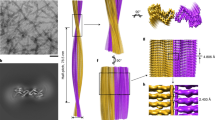Abstract
Prions are the proteinaceous infectious agents responsible for the transmission of prion diseases. The main or sole component of prions is the misfolded prion protein (PrPSc), which is able to template the conversion of the host's natively folded form of the protein (PrPC). The detailed mechanism of prion replication and the high-resolution structure of PrPSc are unknown. The currently available information on PrPSc structure comes mostly from low-resolution biophysical techniques, which have resulted in quite divergent models. Recent advances in the production of infectious prions, using very pure recombinant protein, offer new hope for PrPSc structural studies. This review highlights the importance of, challenges for and recent progress toward elucidating the elusive structure of PrPSc, arguably the major pending milestone to reach in understanding prions.
This is a preview of subscription content, access via your institution
Access options
Subscribe to this journal
Receive 12 print issues and online access
$189.00 per year
only $15.75 per issue
Buy this article
- Purchase on Springer Link
- Instant access to full article PDF
Prices may be subject to local taxes which are calculated during checkout


Similar content being viewed by others
References
Delez, A.L., Gustafson, D.P. & Luttrell, C.N. Some clinical and histological observations on scrapie in sheep. J. Am. Vet. Med. Assoc. 131, 439–446 (1957).
Collinge, J. Prion diseases of humans and animals: their causes and molecular basis. Annu. Rev. Neurosci. 24, 519–550 (2001).
Alper, T. Scrapie agent unlike viruses in size and susceptibility to inactivation by ionizing or ultraviolet radiation. Nature 317, 750 (1985).
Gajdusek, D.C., Gibbs, C.J. & Alpers, M. Experimental transmission of a Kuru-like syndrome to chimpanzees. Nature 209, 794–796 (1966).
Hope, J., Ritchie, L., Farquhar, C., Somerville, R. & Hunter, N. Bovine spongiform encephalopathy: a scrapie-like disease of British cattle. Prog. Clin. Biol. Res. 317, 659–667 (1989).
Will, R.G. et al. A new variant of Creutzfeldt-Jakob disease in the UK. Lancet 347, 921–925 (1996).
Collinge, J. Variant Creutzfeldt-Jakob disease. Lancet 354, 317–323 (1999).
Soto, C. & Castilla, J. The controversial protein-only hypothesis of prion propagation. Nat. Med. 10, S63–S67 (2004).
Griffith, J.S. Self-replication and scrapie. Nature 215, 1043–1044 (1967).
Bolton, D.C., McKinley, M.P. & Prusiner, S.B. Identification of a protein that purifies with the scrapie prion. Science 218, 1309–1311 (1982).
McKinley, M.P., Bolton, D.C. & Prusiner, S.B. A protease-resistant protein is a structural component of the scrapie prion. Cell 35, 57–62 (1983).
Stahl, N. et al. Structural studies of the scrapie prion protein using mass spectrometry and amino acid sequencing. Biochemistry 32, 1991–2002 (1993).
Pan, K.M. et al. Conversion of alpha-helices into beta-sheets features in the formation of the scrapie prion proteins. Proc. Natl. Acad. Sci. USA 90, 10962–10966 (1993).
Prusiner, S.B. Prions. Proc. Natl. Acad. Sci. USA 95, 13363–13383 (1998).
Soto, C. Prion hypothesis: the end of the controversy? Trends Biochem. Sci. 36, 151–158 (2011).
Büeler, H. et al. Mice devoid of PrP are resistant to scrapie. Cell 73, 1339–1347 (1993).
Jackson, W.S. et al. Spontaneous generation of prion infectivity in fatal familial insomnia knockin mice. Neuron 63, 438–450 (2009).
Sigurdson, C.J. et al. De novo generation of a transmissible spongiform encephalopathy by mouse transgenesis. Proc. Natl. Acad. Sci. USA 106, 304–309 (2009).
Castilla, J., Saá, P., Hetz, C. & Soto, C. In vitro generation of infectious scrapie prions. Cell 121, 195–206 (2005).
Deleault, N.R., Harris, B.T., Rees, J.R. & Supattapone, S. From the cover: formation of native prions from minimal components in vitro. Proc. Natl. Acad. Sci. USA 104, 9741–9746 (2007).
Wang, F., Wang, X., Yuan, C.-G. & Ma, J. Generating a prion with bacterially expressed recombinant prion protein. Science 327, 1132–1135 (2010).
Castilla, J. et al. Cell-free propagation of prion strains. EMBO J. 27, 2557–2566 (2008).
Chiti, F. & Dobson, C.M. Protein misfolding, functional amyloid, and human disease. Annu. Rev. Biochem. 75, 333–366 (2006).
Silveira, J.R. et al. The most infectious prion protein particles. Nature 437, 257–261 (2005).
Tixador, P. et al. The physical relationship between infectivity and prion protein aggregates is strain-dependent. PLoS Pathog. 6, e1000859 (2010).
Riek, R. et al. NMR structure of the mouse prion protein domain PrP(121–321). Nature 382, 180–182 (1996).
Jarrett, J.T. & Lansbury, P.T. Jr. Seeding “one-dimensional crystallization” of amyloid: a pathogenic mechanism in Alzheimer's disease and scrapie? Cell 73, 1055–1058 (1993).
Soto, C., Estrada, L. & Castilla, J. Amyloids, prions and the inherent infectious nature of misfolded protein aggregates. Trends Biochem. Sci. 31, 150–155 (2006).
Caughey, B., Baron, G.S., Chesebro, B. & Jeffrey, M. Getting a grip on prions: oligomers, amyloids, and pathological membrane interactions. Annu. Rev. Biochem. 78, 177–204 (2009).
McKinley, M.P., Braunfeld, M.B., Bellinger, C.G. & Prusiner, S.B. Molecular characteristics of prion rods purified from scrapie-infected hamster brains. J. Infect. Dis. 154, 110–120 (1986).
Gabizon, R., McKinley, M.P. & Prusiner, S.B. Purified prion proteins and scrapie infectivity copartition into liposomes. Proc. Natl. Acad. Sci. USA 84, 4017–4021 (1987).
Riesner, D. et al. Disruption of prion rods generates 10-nm spherical particles having high alpha-helical content and lacking scrapie infectivity. J. Virol. 70, 1714–1722 (1996).
Wille, H., Zhang, G.F., Baldwin, M.A., Cohen, F.E. & Prusiner, S.B. Separation of scrapie prion infectivity from PrP amyloid polymers. J. Mol. Biol. 259, 608–621 (1996).
Pastrana, M.A. et al. Isolation and characterization of a proteinase K-sensitive PrPSc fraction. Biochemistry 45, 15710–15717 (2006).
Cobb, N.J. & Surewicz, W.K. Prion diseases and their biochemical mechanisms. Biochemistry 48, 2574–2585 (2009).
Diringer, H. et al. Highly infectious purified preparations of disease-specific amyloid of transmissible spongiform encephalopathies are not devoid of nucleic acids of viral size. Intervirology 40, 238–246 (1997).
Leffers, K.W. et al. Assembly of natural and recombinant prion protein into fibrils. Biol. Chem. 386, 569–580 (2005).
Cobb, N.J., Apetri, A.C. & Surewicz, W.K. Prion protein amyloid formation under native-like conditions involves refolding of the C-terminal alpha-helical domain. J. Biol. Chem. 283, 34704–34711 (2008).
Baskakov, I.V., Legname, G., Baldwin, M.A., Prusiner, S.B. & Cohen, F.E. Pathway complexity of prion protein assembly into amyloid. J. Biol. Chem. 277, 21140–21148 (2002).
Bocharova, O.V., Breydo, L., Parfenov, A.S., Salnikov, V.V. & Baskakov, I.V. In vitro conversion of full-length mammalian prion protein produces amyloid form with physical properties of PrPSc. J. Mol. Biol. 346, 645–659 (2005).
Jackson, G.S. et al. Reversible conversion of monomeric human prion protein between native and fibrilogenic conformations. Science 283, 1935–1937 (1999).
May, B.C., Govaerts, C., Prusiner, S.B. & Cohen, F.E. Prions: so many fibers, so little infectivity. Trends Biochem. Sci. 29, 162–165 (2004).
Legname, G. et al. Synthetic mammalian prions. Science 305, 673–676 (2004).
Westaway, D. et al. Degeneration of skeletal muscle, peripheral nerves, and the central nervous system in transgenic mice overexpressing wild-type prion proteins. Cell 76, 117–129 (1994).
Chiesa, R., Piccardo, P., Ghetti, B. & Harris, D.A. Neurological illness in transgenic mice expressing a prion protein with an insertional mutation. Neuron 21, 1339–1351 (1998).
Nazor, K.E. et al. Immunodetection of disease-associated mutant PrP, which accelerates disease in GSS transgenic mice. EMBO J. 24, 2472–2480 (2005).
Colby, D.W. et al. Design and construction of diverse mammalian prion strains. Proc. Natl. Acad. Sci. USA 106, 20417–20422 (2009).
Colby, D.W. et al. Protease-sensitive synthetic prions. PLoS Pathog. 6, e1000736 (2010).
Makarava, N. et al. Recombinant prion protein induces a new transmissible prion disease in wild-type animals. Acta Neuropathol. 119, 177–187 (2010).
Wille, H. et al. Natural and synthetic prion structure from X-ray fiber diffraction. Proc. Natl. Acad. Sci. USA 106, 16990–16995 (2009).
Piro, J.R. et al. Seeding specificity and ultrastructural characteristics of infectious recombinant prions. Biochemistry 50, 7111–7116 (2011).
Smirnovas, V. et al. Structural organization of brain-derived mammalian prions examined by hydrogen-deuterium exchange. Nat. Struct. Mol. Biol. 18, 504–506 (2011).
Kocisko, D.A. et al. Cell-free formation of protease-resistant prion protein. Nature 370, 471–474 (1994).
Saborio, G.P., Permanne, B. & Soto, C. Sensitive detection of pathological prion protein by cyclic amplification of protein misfolding. Nature 411, 810–813 (2001).
Castilla, J. et al. Crossing the species barrier by PrPSc replication in vitro generates unique infectious prions. Cell 134, 757–768 (2008).
Meyerett, C. et al. In vitro strain adaptation of CWD prions by serial protein misfolding cyclic amplification. Virology 382, 267–276 (2008).
Kim, J.I., Surewicz, K., Gambetti, P. & Surewicz, W.K. The role of glycophosphatidylinositol anchor in the amplification of the scrapie isoform of prion protein in vitro. FEBS Lett. 583, 3671–3675 (2009).
Wang, F. et al. Genetic informational RNA is not required for recombinant prion infectivity. J. Virol. 86, 1874–1876 (2012).
Kim, J.I. et al. Mammalian prions generated from bacterially expressed prion protein in the absence of any mammalian cofactors. J. Biol. Chem. 285, 14083–14087 (2010).
Supattapone, S. Biochemistry. What makes a prion infectious? Science 327, 1091–1092 (2010).
Abid, K., Morales, R. & Soto, C. Cellular factors implicated in prion replication. FEBS Lett. 584, 2409–2414 (2010).
Deleault, N.R., Lucassen, R.W. & Supattapone, S. RNA molecules stimulate prion protein conversion. Nature 425, 717–720 (2003).
Cordeiro, Y. & Silva, J.L. The hypothesis of the catalytic action of nucleic acid on the conversion of prion protein. Protein Pept. Lett. 12, 251–255 (2005).
Caughey, B. Protease-resistant PrP accumulation and scrapie agent replication: a role for sulphated glycosaminoglycans? Biochem. Soc. Trans. 22, 163–167 (1994).
Cordeiro, Y. et al. DNA converts cellular prion protein into the beta-sheet conformation and inhibits prion peptide aggregation. J. Biol. Chem. 276, 49400–49409 (2001).
Adler, V. et al. Small, highly structured RNAs participate in the conversion of human recombinant PrP(Sen) to PrP(Res) in vitro. J. Mol. Biol. 332, 47–57 (2003).
Geoghegan, J.C. et al. Selective incorporation of polyanionic molecules into hamster prions. J. Biol. Chem. 282, 36341–36353 (2007).
Piro, J.R., Harris, B.T. & Supattapone, S. In situ photodegradation of incorporated polyanion does not alter prion infectivity. PLoS Pathog. 7, e1002001 (2011).
Nelson, R. & Eisenberg, D. Structural models of amyloid-like fibrils. Adv. Protein Chem. 73, 235–282 (2006).
Nelson, R. et al. Structure of the cross-β spine of amyloid-like fibrils. Nature 435, 773–778 (2005).
Wasmer, C. et al. Amyloid fibrils of the HET-s(218–289) prion form a β solenoid with a triangular hydrophobic core. Science 319, 1523–1526 (2008).
Safar, J., Roller, P.P., Gajdusek, D.C. & Gibbs, C.J. Jr. Conformational transitions, dissociation, and unfolding of scrapie amyloid (prion) protein. J. Biol. Chem. 268, 20276–20284 (1993).
Caughey, B.W. et al. Secondary structure analysis of the scrapie-associated protein PrP 27–30 in water by infrared spectroscopy. Biochemistry 30, 7672–7680 (1991).
Baldwin, M.A. et al. Spectroscopic characterization of conformational differences between PrPC and PrPSc: an α-helix to β-sheet transition. Phil. Trans. R. Soc. Lond. B 343, 435–441 (1994).
Aucouturier, P., Kascsak, R.J., Frangione, B. & Wisniewski, T. Biochemical and conformational variability of human prion strains in sporadic Creutzfeldt-Jakob disease. Neurosci. Lett. 274, 33–36 (1999).
Caughey, B., Raymond, G.J. & Bessen, R.A. Strain-dependent differences in β-sheet conformations of abnormal prion protein. J. Biol. Chem. 273, 32230–32235 (1998).
Chesebro, B. et al. Anchorless prion protein results in infectious amyloid disease without clinical scrapie. Science 308, 1435–1439 (2005).
Baron, G.S. et al. Effect of glycans and the glycophosphatidylinositol anchor on strain dependent conformations of scrapie prion protein: improved purifications and infrared spectra. Biochemistry 50, 4479–4490 (2011).
Parchi, P. et al. Molecular basis of phenotypic variability in sporadic Creutzfeldt-Jakob disease. Ann. Neurol. 39, 767–778 (1996).
Cronier, S. et al. Detection and characterization of proteinase K-sensitive disease-related prion protein with thermolysin. Biochem. J. 416, 297–305 (2008).
Supattapone, S. et al. Prion protein of 106 residues creates an artifical transmission barrier for prion replication in transgenic mice. Cell 96, 869–878 (1999).
Bessen, R.A. & Marsh, R.F. Distinct PrP properties suggest the molecular basis of strain variation in transmissible mink encephalopathy. J. Virol. 68, 7859–7868 (1994).
Peretz, D. et al. A conformational transition at the N terminus of the prion protein features in formation of the scrapie isoform. J. Mol. Biol. 273, 614–622 (1997).
Williamson, R.A. et al. Mapping the prion protein using recombinant antibodies. J. Virol. 72, 9413–9418 (1998).
Merz, P.A., Somerville, R.A., Wisniewski, H.M., Manuelidis, L. & Manuelidis, E.E. Scrapie-associated fibrils in Creutzfeldt-Jakob disease. Nature 306, 474–476 (1983).
Sim, V.L. & Caughey, B. Ultrastructures and strain comparison of under-glycosylated scrapie prion fibrils. Neurobiol. Aging 30, 2031–2042 (2009).
Ayers, J.I. et al. The strain-encoded relationship between PrP replication, stability and processing in neurons is predictive of the incubation period of disease. PLoS Pathog. 7, e1001317 (2011).
Deleault, A.M., Deleault, N.R., Harris, B.T., Rees, J.R. & Supattapone, S. The effects of prion protein proteolysis and disaggregation on the strain properties of hamster scrapie. J. Gen. Virol. 89, 2642–2650 (2008).
Eanes, E.D. & Glenner, G.G. X-ray diffraction studies on amyloid filaments. J. Histochem. Cytochem. 16, 673–677 (1968).
Govaerts, C., Wille, H., Prusiner, S.B. & Cohen, F.E. Evidence for assembly of prions with left-handed β-helices into trimers. Proc. Natl. Acad. Sci. USA 101, 8342–8347 (2004).
Serag, A.A., Altenbach, C., Gingery, M., Hubbell, W.L. & Yeates, T.O. Arrangement of subunits and ordering of β-strands in an amyloid sheet. Nat. Struct. Biol. 9, 734–739 (2002).
Cobb, N.J., Sonnichsen, F.D., McHaourab, H. & Surewicz, W.K. Molecular architecture of human prion protein amyloid: a parallel, in-register β-structure. Proc. Natl. Acad. Sci. USA 104, 18946–18951 (2007).
Schuler, B., Rachel, R. & Seckler, R. Formation of fibrous aggregates from a non-native intermediate: the isolated P22 tailspike β-helix domain. J. Biol. Chem. 274, 18589–18596 (1999).
Junker, M. et al. Pertactin β-helix folding mechanism suggests common themes for the secretion and folding of autotransporter proteins. Proc. Natl. Acad. Sci. USA 103, 4918–4923 (2006).
DeMarco, M.L. & Daggett, V. From conversion to aggregation: protofibril formation of the prion protein. Proc. Natl. Acad. Sci. USA 101, 2293–2298 (2004).
Surewicz, W.K., Mantsch, H.H. & Chapman, D. Determination of protein secondary structure by Fourier transform infrared spectroscopy: a critical assessment. Biochemistry 32, 389–394 (1993).
Wilder, C.L., Friedrich, A.D., Potts, R.O., Daumy, G.O. & Francoeur, M.L. Secondary structural analysis of two recombinant murine proteins, interleukins 1 alpha and 1 beta: is infrared spectroscopy sufficient to assign structure? Biochemistry 31, 27–31 (1992).
Brundin, P., Melki, R. & Kopito, R. Prion-like transmission of protein aggregates in neurodegenerative diseases. Nat. Rev. Mol. Cell Biol. 11, 301–307 (2010).
Frost, B. & Diamond, M.I. Prion-like mechanisms in neurodegenerative diseases. Nat. Rev. Neurosci. 11, 155–159 (2010).
Aguzzi, A. Cell biology: beyond the prion principle. Nature 459, 924–925 (2009).
Westermark, G.T. & Westermark, P. Prion-like aggregates: infectious agents in human disease. Trends Mol. Med. 16, 501–507 (2010).
Soto, C. & Estrada, L.D. Protein misfolding and neurodegeneration. Arch. Neurol. 65, 184–189 (2008).
Wickner, R.B. et al. Prions: proteins as genes and infectious entities. Genes Dev. 18, 470–485 (2004).
Uptain, S.M. & Lindquist, S. Prions as protein-based genetic elements. Annu. Rev. Microbiol. 56, 703–741 (2002).
Halfmann, R., Alberti, S. & Lindquist, S. Prions, protein homeostasis, and phenotypic diversity. Trends Cell Biol. 20, 125–133 (2010).
Halfmann, R. et al. Prions are a common mechanism for phenotypic inheritance in wild yeasts. Nature 482, 363–368 (2012).
Toyama, B.H., Kelly, M.J., Gross, J.D. & Weissman, J.S. The structural basis of yeast prion strain variants. Nature 449, 233–237 (2007).
Collinge, J. & Clarke, A.R. A general model of prion strains and their pathogenicity. Science 318, 930–936 (2007).
Acknowledgements
We are very grateful to V. Daggett and W. Chen from the University of Washington in Seattle for kindly providing a model for the β-spiral structure of PrPSc. We also want to thank W. Surewicz from Case Western Reserve University for providing high-resolution pictures for the extended in-register β-sheet model and H. Wille from University of California, San Francisco, for providing structural coordinates for the β-helix model. This work was funded in part by US National Institutes of Health grant R01NS041973 to C.S.
Author information
Authors and Affiliations
Corresponding author
Ethics declarations
Competing interests
The authors declare no competing financial interests.
Rights and permissions
About this article
Cite this article
Diaz-Espinoza, R., Soto, C. High-resolution structure of infectious prion protein: the final frontier. Nat Struct Mol Biol 19, 370–377 (2012). https://doi.org/10.1038/nsmb.2266
Published:
Issue Date:
DOI: https://doi.org/10.1038/nsmb.2266
This article is cited by
-
Excess PrPC inhibits muscle cell differentiation via miRNA-enhanced liquid–liquid phase separation implicated in myopathy
Nature Communications (2023)
-
Review on PRNP genetics and susceptibility to chronic wasting disease of Cervidae
Veterinary Research (2021)
-
Functional genomics screen identifies proteostasis targets that modulate prion protein (PrP) stability
Cell Stress and Chaperones (2021)
-
Cryo-EM structure of an amyloid fibril formed by full-length human prion protein
Nature Structural & Molecular Biology (2020)
-
Protein misfolding, aggregation, and conformational strains in neurodegenerative diseases
Nature Neuroscience (2018)



